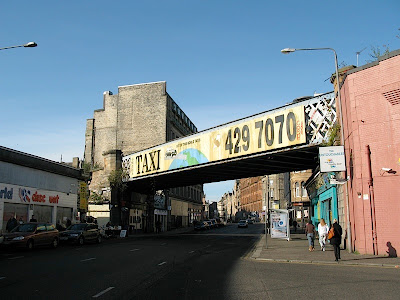The Calton area runs (or if you accept the WHO figures, limps) from Glasgow Cross to Bridgeton, bounded also by Dennistoun and Parkhead. In 2008, the World Health Organisation declared that Calton had the worst male life expectancy in Europe. The figures are hotly disputed by local activists, who argue that the figures are unfairly skewed because of a few streets - the Herald's demolition of the figures can be found here -
http://www.heraldscotland.com/now-calton-fights-back-1.834914
The skewing of the figures happens because the council has placed hostels in the area in which single homeless men at the end of their tether are parked - and sometimes die there. I once cycled past a group of such men huddled round one of their number and passed without asking if I could help. When I cycled back in half an hour an ambulance was taking the body away - the poor guy had been dead on the ground when I passed earlier. As the Herald says
'Following a World Health Organisation (WHO) report in August, in which Calton was identified as having the lowest male life expectancy in Europe, the British press descended in numbers, as they had in the past, looking for ways to put flesh on the story's bones. Calton's men die at 54, claimed the report. (Its women do considerably better at 74, although this is rarely mentioned). Print and television reporters asked young mothers how they felt about their children's diminished life chances, even as those infants ga-gad in their parents' arms. More galling for locals was the choice of camera shots used to illustrate Calton's grim reputation as a hive of multiple deprivation: a boarded-up window here, a broken wine bottle there. The area's more presentable streets were either erased or never recorded; footage of residents with anything positive to say was left languishing on the cutting room floor.'
See also
http://www.caltonarea.org.uk/
http://glasgowalbum.blogspot.com/2010/09/welcome-to-glasgow-dalmarnock-road.html
and the Calton Heritage Trail
http://www.glasgow.gov.uk/NR/rdonlyres/8A648E9C-BDF7-4555-A0BC-716F66D35E7D/0/Heritagetrail_Calton2_web.pdf |






















































_l_l.jpg)

The skewing of the figures happens because the council has placed hostels in the area in which single homeless men at the end of their tether are parked - and sometimes die there. london apartments
ReplyDeleteThe shop at the junction of Bain st was Margaret Forresters, one of the old shops that sold clothes,and household things..
ReplyDeleteYes, I remember Margaret Forresters. It also sold furniture of reasonable quality. My mum used to take me into that shop in the 1950s. I haven't been back to the UK since 1980 (emigrated 1970). The place looks no better notwithstanding all the new developments. I see that all the churches (save the RC church) have gone. I recall one every two blocks ... and two pubs every one block.
ReplyDeleteI could have written exactly what you wrote. My mum also took me on occasion to Margaret Foresters in the 1950s. I emigrated in 1971 and haven't been back since 1981. The place actually looks no different from what I recall (London Road, Bain Street, etc.), notwithstanding all the redevelopment. Interesting to see all the churches (except St. Alphonsus) gone.
DeleteI got raped by 3 men one the cafe as he got back staer key toilet i was only 6 i am thy to find out the name of the cafe plaese i on facbook Joe Biggins my wee girls in the pic thanks
ReplyDelete